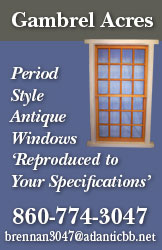The New England landscape – indeed, the view across the entire country – is dotted with one-room schoolhouses, most abandoned and in various states of casual preservation or fateful disrepair, evoking a quaint, quiet sense of times past.
But one old schoolhouse in Monroe Center defies this vision as it vibrates on many school days with children’s voices, because school is again in session at the old one-room school. Several thousand people have visited or spent a day in learning at the restored building.
It is a curious intermingling of past and present at the old school, where modern children, often clothed in colonial-type garments, are playing a game in the schoolyard, or taking the obligatory trip to the outhouse.
A project of the Monroe Historical Society, the relocation, restoration, and brisk usage of the old East Village schoolhouse, circa 1790, is also a source of local pride. The $10,000 restoration was slow and careful, owing to a sparsity of funds and the painstaking detail required by the former Society President Edward N. Coffey, who was overseer of the process.
Monroe’s half-dozen or so one-room schoolhouses were sold at public auction in 1935, when the Monroe Consolidated School was completed to educate the first eight grades in town, and the East Village schoolhouse was the property of a Methodist Church when it was about to be torn down in its original section of town. But the Historical Society saved it, and in 1969 moved it to its present site on Wheeler Road, because the Society owns the tract of land, along with an old house and small barn.
Ironically, the Monroe Center schoolhouse stood just the road from the place now occupied by the East Village School. The old Monroe Center schoolhouse is now attached to the rear of a building two blocks away, owned by the Monroe Congregational Church.
Opened on a cold dedication day in October, 1973 the East Village School includes the schoolhouse bell used there by the last teacher who taught in the “old days,” and a schoolmaster’s desk given by the family of a man who bought it at the public auction in 1935. The desk was used in another of Monroe’s one-room schoolhouses, on Cutler Farm Road.
Many old slates and slate pencils were donated by former students of Monroe’s various one-room schoolhouses, and the old outhouse in the back is also a Monroe original, given by a family on Pepper Street. The brick fireplace in the building was restored using funds from a gift in memory of one of the Society’s original members, and the clock on its mantel was donated by an East Village resident on many years.
The shingles on the building were given by a local lumber company, and the cedar flagpole outside is from a tree farm on the town line near White Hills. The Girl Scouts planted a laurel tree, a local nursery- man donated the myrtle around the foundation, and one of the local teacher organizations gave money to have reproduction wooden tables and benches built for the inside. The same teachers’ group who equipped the building with an authentic fifteen-star flag which children raise each morning on which the school is visited.
Local people gave treasured items and relics, as well as much time and money, to restore the building properly. A loaned copy of a Winslow Homer painting Country School, done in 1871, stands on the mantel because it was used as a guide for restoring the schoolhouse. It has many features in common with the Monroe school, including the windows (twelve-over-eight panes), arched ceiling, and the blackboard between two windows at one end. Thus, the benches and tables at East Village schoolhouse are built just as they appear in Homer’s painting.
The blackboard is not of 1790 vintage, but is retained for the convenience of modern-day teachers who visit the school with a class to learn “the old-fashioned way” for a day. Very often these visits are related to a colonial studies unit, or are a class outing. |

 Structural Products & Services, Stairlifts
Structural Products & Services, Stairlifts





